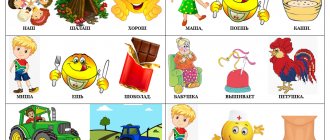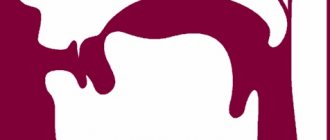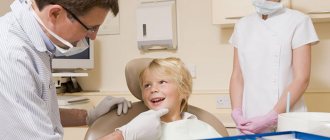Ronchopathy is being treated and this is already good. In addition, you can get rid of it in a very cheap way - with the help of tongue gymnastics. By choosing effective exercises, they will prevent its return after therapy. This technique is also suitable for preventive measures. A complex for the tongue is exactly what you need to do every day, then there will be a lasting effect.
So, with the help of physical education, you can significantly strengthen the muscles of the tongue, which your illness will not like. Of course, we are not talking about a complete treatment of apnea - what we offer is only part of a large therapeutic complex. Half an hour of exercise a day for a month, and you and your household will like the results.
Exercises to normalize breathing function
Exercise No. 1 Full breathing. Take a long breath through your nose. During inhalation, the abdomen “inflates”, then the chest expands. When you exhale (through the nose), on the contrary, the volume of the chest first decreases, then the stomach retracts.
Exercise No. 2 Chest breathing. Exhale. Take a long breath through your nose. At this time, the chest expands and the stomach retracts. When you exhale (through the nose), the stomach retracts.
Exercise No. 3 Abdominal breathing. Exhale. Take a long breath through your nose. At this time, the stomach protrudes. When you exhale (through the nose), the stomach retracts.
Exercise No. 4 The skill of full, extended exhalation. Walk at an average pace. Inhale and exhale only through the nose. Inhale for three steps, exhale for four steps. After three to four days, the duration of exhalation should be increased by one count (5,6, etc.)
Exercise No. 5 Inhale and exhale alternately through one nostril (press the second nostril tightly with your finger).
Exercises to train the muscles of the tongue and normalize the type of swallowing
Exercise No. 1 “Clock”. The mouth is open, the tongue makes slow circular movements along the upper lip, then along the lower lip.
Exercise No. 2 “Punish the naughty tongue.” Place your tongue on your lower lip and slap it with your upper lip “na-na.”
Exercise No. 3 “We will paint the ceiling.” It's time to paint the rooms, they invited a molar, he comes to the old house with a new brush and bucket. Your tongues are a brush, your hard palate is the ceiling...
Exercise No. 4 Depict the operation of a jackhammer. DDDD...
Exercise No. 5 “Riders”. Sit astride a chair and, opening your mouth wide, click your tongue.
Exercises to normalize breathing function
Exercise No. 1 Full breathing. Take a long breath through your nose. During inhalation, the abdomen “inflates”, then the chest expands. When you exhale (through the nose), on the contrary, the volume of the chest first decreases, then the stomach retracts.
Exercise No. 2 Chest breathing. Exhale. Take a long breath through your nose. At this time, the chest expands and the stomach retracts. When you exhale (through the nose), the stomach retracts.
Exercise No. 3 Abdominal breathing. Exhale. Take a long breath through your nose. At this time, the stomach protrudes. When you exhale (through the nose), the stomach retracts.
Exercise No. 4 The skill of full, extended exhalation. Walk at an average pace. Inhale and exhale only through the nose. Inhale for three steps, exhale for four steps. After three to four days, the duration of exhalation should be increased by one count (5,6, etc.)
Exercise No. 5 Inhale and exhale alternately through one nostril (press the second nostril tightly with your finger).
Exercise No. 6 Exhale. Pinch your nose with your fingers. Slowly count out loud to 5, then take a deep breath and exhale through your nose.
Exercises to strengthen the pharyngeal muscles
Exercise No. 1 Alternately tilt your head back as much as possible, leaning forward.
Exercise No. 2 Throw your head back. In this position, alternately tilt your head towards the right and left shoulder.
Exercise No. 3 Throw your head back, in this position alternately turn your head, without releasing your chin, to the right, then to the left.
Dietary recommendations
A balanced diet is an important part of cancer treatment. If you have pain when swallowing or have trouble swallowing:
- You may not be able to eat enough food. This may cause you to lose weight or have low energy.
- You may not be able to drink enough fluids. This can lead to dehydration.
Your swallowing specialist, nurse, doctor, and clinical dietitian dietitian will tell you what you should eat and drink during treatment. Your swallowing specialist will recommend foods and liquids that have the right consistency. When you try new foods and liquids, make sure they are the consistency recommended by your swallowing specialist.
Your healthcare team may also recommend that you take a nutritional supplement (such as Ensure®) to increase your calorie intake. You can buy dietary supplements at your local grocery store, pharmacy, or order online.
For more dietary advice, see Eating Well During Cancer Treatment and Guidelines for Puréed and Soft Diets.
Control dry mouth or thick saliva
Try the following tips if dry mouth or thick saliva is bothering you:
- Drink 8–10 cups of fluid per day. Getting enough fluid in your body will help make your saliva thinner.
- Carry a bottle of water or other liquid with you when you leave the house. Take small sips of it often.
- Chew sugarless gum or suck on sugarless hard candies. This may stimulate saliva production.
- Add sauces, gravies and other liquids to food.
- Use a humidifier to help thin your saliva and other secretions.
- Rinse your mouth frequently throughout the day with a mixture of 1 liter (about 4.5 cups) of water, 1 teaspoon of salt and 1 teaspoon of baking soda. You can drink the mixture in small sips, rinse your mouth with it, or gargle.
to come back to the beginning
Exercises to normalize the function of lip closure
Exercise No. 1 Pull your lips forward, close them, draw a tube, and stretch them wide.
Exercise No. 2 Pull your lips forward, close them, depict a mouthpiece, a proboscis.
Exercise No. 3 Close your lips, puff out your cheeks, slowly squeeze the air through your clenched lips with your fists.
Exercise No. 4 Close your lips, then move them alternately to the right and left.
Exercise No. 5 Close your lips, blow air under your upper lip, then under your lower lip.
Exercise No. 6 Place bent little fingers in the corners of the mouth, do not close your lips, spread your fingers slightly to the sides, close your lips.
Exercise No. 7 Blow out a stream of air with force (“a breeze is blowing,” let’s put out the candle,” “let’s make a storm,” etc.).
Working on diction and pronunciation
Oratorical talent is extremely rare. Almost all famous people intensively prepare for every public appearance. It is known that Cicero could not utter a single word without preparation. And he is still held up as an example as a great rhetorician.
There are many exercises with which your speech can become clear and beautiful. Among them are both universal exercises and those that are designed to help correct a specific problem. For example, a whistling “S”, an indistinct “L” or a violation in the pronunciation of the sound “R”. In order to solve these problems you will have to work.
Exercises to train the muscles of the tongue and normalize the type of swallowing
Exercise No. 1 “Clock”. The mouth is open, the tongue makes slow circular movements along the upper lip, then along the lower lip.
Exercise No. 2 “Punish the naughty tongue.” Place your tongue on your lower lip and slap it with your upper lip “na-na.”
Exercise No. 3 “We will paint the ceiling.” It's time to paint the rooms, they invited a molar, he comes to the old house with a new brush and bucket. Your tongues are a brush, your hard palate is the ceiling...
Exercise No. 4 Depict the operation of a jackhammer. DDDD...
Exercise No. 5 “Riders”. Sit astride the toilet seat and, opening your mouth wide, click your tongue.
Exercise No. 6 Lift the tongue up, press it to the front part of the hard palate in the area of the palatine folds. Clench your teeth, swallow saliva, fixing the position of your tongue.
Exercise No. 7 Raise the tip of the tongue up and place it at the anterior part of the hard palate. Move the tongue along the arch of the hard palate as far back as possible to the soft palate.
Exercise No. 8 Raise the tip of the tongue up and place it at the anterior part of the hard palate. Move your tongue along the palatal surface of the teeth on the right and left, touching each tooth.
Speech diction
Diction is the clear pronunciation of sounds and words with their correct articulation. The speech apparatus produces sounds, and its violations and defects are the reason that a person’s diction is of low quality.
Speech diction consists of:
- From distinct articulation;
- Correct articulation;
- Manner of pronunciation: tempo and intonation.
Clear articulation - correct and clear pronunciation of sounds. It is thanks to clear articulation that the speaker’s speech is legible and his interlocutors easily understand what he wants to convey. Violation of this indicator of diction may occur due to the physiological characteristics of a person. You can improve the clarity of pronunciation of sounds by training your tongue and lip muscles.
Correct articulation is the coordinated movement of the muscles of the articulatory apparatus. Malocclusions and frenulums have a negative effect on articulation. With such physiological deviations, burr and nasal sound may appear.
Timbre. Often, the manner of pronunciation is influenced by a person’s temperament. The speaker may tend to monotony or speed up his speech. Often it is haste that occurs in people with poor diction. But, as practice shows, almost anyone can “defeat” this problem.
Intonation. As for intonation, it is formed primarily from the ability to clearly pronounce vowel sounds and stress. You can set intonation with the help of some breathing exercises and reading aloud. Improving intonation is very difficult and painstaking work.
Exercises to normalize breathing function
Exercise No. 1 Full breathing. Take a long breath through your nose. During inhalation, the abdomen “inflates”, then the chest expands. When you exhale (through the nose), on the contrary, the volume of the chest first decreases, then the stomach retracts.
Exercise No. 2 Chest breathing. Exhale. Take a long breath through your nose. At this time, the chest expands and the stomach retracts. When you exhale (through the nose), the stomach retracts.
Exercise No. 3 Abdominal breathing. Exhale. Take a long breath through your nose. At this time, the stomach protrudes. When you exhale (through the nose), the stomach retracts.
Exercise No. 4 The skill of full, extended exhalation. Walk at an average pace. Inhale and exhale only through the nose. Inhale for three steps, exhale for four steps. After three to four days, the duration of exhalation should be increased by one count (5,6, etc.)
Exercise No. 5 Inhale and exhale alternately through one nostril (press the second nostril tightly with your finger).
Additional special exercises
Exercise No. 1. Slowly push the lower jaw forward until the cutting edges of the lower incisors are positioned in front of the upper ones. Hold the lower jaw in this position for 10 seconds, then slowly return to its original position.
Exercise No. 2. Perform the same exercise with a spank of the head, first to the right, then to the left. The load increases when performing the exercise while standing. The head is slightly tilted back, the lower jaw is slowly pushed forward until the lower incisors are positioned in front of the upper ones.
Exercise No. 3 (with the vestibular plate). The vestibular plate is placed in the vestibule of the oral cavity, with 1 finger of the right hand it is pulled forward by the ring and held with pursed lips.
Exercise No. 4. Place a folded strip of paper between your lips and purse your lips. The paper is held for up to 30-50 minutes during quiet games, drawing, reading, or when the child is watching TV.
Exercise No. 5. Perform the previous exercise, replace the strip of paper with a metal disk with a diameter of 2.5-3 cm, a thickness of 1.5 mm and a mass of about 6.5 g. The disk clamped between the lips should be positioned horizontally, it is necessary to ensure that the disk is only clamped lips, not teeth. The exercise is performed until fatigue (from 30 seconds to several minutes).
Exercise No. 6 (with a plastic plate). The child presses the edge of the plate, 1-2 mm thick and 30-35 mm wide, with his lips. 60-120 mm long. and holds it in a horizontal position. Some kind of weight is placed on the plate. Increasing the load causes increased clenching of the lips.
Exercise No. 7. Small cotton rolls are placed in the area of the transitional fold of the vestibule of the oral cavity on both sides of the frenulum of the upper lip. Close your lips and pronounce a series of phrases containing labial sounds (“b”, “m”, “p”).
Managing swallowing problems
Having trouble swallowing is called dysphagia. Your healthcare team can help you manage your dysphagia. Your team includes doctors, nurses, a swallowing specialist, and a clinical dietitian.
You will meet with a swallowing specialist before, during, and after treatment. This specialist:
- explain how treatment may affect swallowing;
- will teach you how to perform exercises to stretch and strengthen the muscles involved in swallowing;
- will monitor any changes in your ability to swallow as you progress through radiotherapy;
- will help you maintain your ability to swallow after treatment ends to prevent long-term or delayed changes.
Pain when swallowing
If you have pain when swallowing, your healthcare team will give you pain medicine to help you manage the pain. Follow your doctor's directions for taking your medication. If it doesn't help, tell your doctor or nurse. There are a wide variety of medications that can be used to relieve this type of pain.
Aspiration
If you have trouble swallowing, food or liquid may accumulate in the back of your throat. This increases the risk of aspiration. Signs of aspiration include:
- cough when swallowing;
- cough after swallowing;
- change in voice while eating or drinking.
If any of these signs occur, contact your swallowing specialist immediately. This specialist will assess whether your ability to swallow has changed and may recommend foods and drinks that are safe to swallow. You will also be given help with swallowing exercises to help prevent your ability to swallow from getting worse.
Call your doctor or nurse right away if you have any of the following symptoms:
- dyspnea;
- whistling when breathing;
- pain when breathing;
- cough with phlegm or mucus;
- temperature 100.4°F (38°C) or higher.
These may be signs of developing pneumonia or a respiratory infection.
Lockjaw
Trismus is a condition where you cannot open your mouth as wide as usual. Trismus can occur at any time, immediately after or even years after treatment.
If you cannot open your mouth wide enough, it will be difficult for your doctor to examine your mouth. This may also be due to other problems, for example:
- Irrigating the mouth and brushing teeth (oral hygiene), which can lead to bad breath, tooth decay and oral infections;
- chewing and swallowing, which may make it difficult for you to eat and drink;
- speech;
- kisses;
- insertion of a breathing tube, for example if you ever need general anesthesia (a drug given to keep you asleep during an operation or procedure);
- carrying out routine dental treatment.
When trismus occurs, its treatment is very difficult. This is why it is important to prevent trismus and treat the condition as early as possible. Your swallowing specialist will teach you exercises to help prevent trismus. It is also important to maintain good oral hygiene and good posture.
to come back to the beginning
Exercises to normalize breathing function
Exercise No. 1 Full breathing. Take a long breath through your nose. During inhalation, the abdomen “inflates”, then the chest expands. When you exhale (through the nose), on the contrary, the volume of the chest first decreases, then the stomach retracts.
Exercise No. 2 Chest breathing. Exhale. Take a long breath through your nose. At this time, the chest expands and the stomach retracts. When you exhale (through the nose), the stomach retracts.
Exercise No. 3 Abdominal breathing. Exhale. Take a long breath through your nose. At this time, the stomach protrudes. When you exhale (through the nose), the stomach retracts.
Exercise No. 4 The skill of full, extended exhalation. Walk at an average pace. Inhale and exhale only through the nose. Inhale for three steps, exhale for four steps. After three to four days, the duration of exhalation should be increased by one count (5,6, etc.)
Exercise No. 5 inhale and exhale alternately through one nostril (press the second nostril tightly with your finger).
Exercises to train the muscles of the tongue and normalize the type of swallowing
Exercise No. 1 “Clock”. The mouth is open, the tongue makes slow circular movements along the upper lip, then along the lower lip.
Exercise No. 2 “Punish the naughty tongue.” Place your tongue on your lower lip and slap it with your upper lip “na-na.”
Exercise No. 3 “We will paint the ceiling.” It's time to paint the rooms, they invited a molar, he comes to the old house with a new brush and bucket. Your tongues are a brush, your hard palate is the ceiling...
Exercise No. 4 Depict the operation of a jackhammer. DDDD...
Exercise No. 5 “Riders”. Sit astride a chair and, opening your mouth wide, click your tongue.
Additional special exercises
Exercise No. 1. Use the tip of your tongue to press on the palatal surfaces of the upper front teeth until the muscles are tired (3-5 minutes).
Exercise No. 2. With the head thrown back, alternately open and close the mouth; when closing the mouth, try to reach the back edge of the hard palate with the tip of the tongue.
Exercise No. 3. Pinch your lower lip with your upper front teeth, hold it, then release it.
Exercise No. 4. Open your mouth, slowly close it, sweeping the lower jaw back and placing the front teeth in marginal closure. Hold the lower jaw in this position for 4-8 seconds.
Exercise No. 5 (with a wooden spatula). A spatula is placed between the teeth (its width is equal to the width of the upper incisors).
Bite the spatula so as to apply pressure on the palatal surfaces of the upper teeth and promote their deflection in the vestibular direction, and the lower incisors in the lingual direction.
About normal swallowing
Figure 1. Organs involved in swallowing
Many muscles and nerves work together to help you swallow (see Figure 1).
When you eat and drink, food and liquid mix with your saliva. Saliva softens and moistens food. Chewing allows you to break down food. When chewed, food and saliva form a bolus.
When swallowing, the tongue pushes food to the back of the mouth. After this, a reflex is triggered, and the root of the tongue pushes food into the esophagus. At this point, the larynx closes to prevent food or liquid from entering the airway (trachea). The food then passes through the esophagus and enters the stomach.
If the muscles in the mouth or throat are weakened, food and liquid can become stuck in the esophagus or enter the airways and lungs. Both of these situations can be dangerous.
The entry of food or liquid into the airways or lungs is called aspiration. Aspiration can lead to complications such as pneumonia (infection of one or both lungs) and respiratory infections (infections that affect the nose, throat, and airways).
to come back to the beginning






